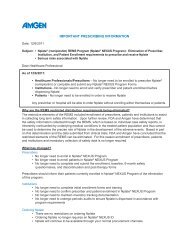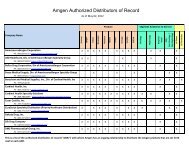Astronomy in Ancient Cultures - Amgen
Astronomy in Ancient Cultures - Amgen
Astronomy in Ancient Cultures - Amgen
Create successful ePaper yourself
Turn your PDF publications into a flip-book with our unique Google optimized e-Paper software.
2009<br />
W<strong>in</strong>n<strong>in</strong>g Lesson Plan<br />
from Lafayette, CO<br />
<strong>Astronomy</strong> <strong>in</strong> <strong>Ancient</strong><br />
<strong>Cultures</strong>: An <strong>in</strong>vestigation<br />
<strong>in</strong> Archeoastronomy<br />
by Emily L. Haynes<br />
Centaurus High School<br />
Subject: <strong>Astronomy</strong><br />
Grade Level: 10<br />
Duration: one week<br />
Overview and Purpose<br />
Students will observe the appearance of the night sky dur<strong>in</strong>g the time and place of an ancient culture<br />
us<strong>in</strong>g previous knowledge of the motion of the sky (relative to the observer), sun, moon and planets<br />
with the sky simulation software "Starry Night Pro". Students will also <strong>in</strong>vestigate the exist<strong>in</strong>g<br />
evidence collected by archeologists left by these cultures about their astronomical observations and<br />
calendars developed. In some cases, myths and legends may have survived which can be<br />
correlated with their astronomical observations.<br />
Connections between the appearance of the night sky and the everyday culture of a people will be<br />
developed by the students through guided-<strong>in</strong>quiry and question<strong>in</strong>g. This summative assessment can<br />
be developed with differentiated outcomes based on the students' <strong>in</strong>terests.<br />
© 2009 <strong>Amgen</strong> Award for Science<br />
Teach<strong>in</strong>g Excellence 1
2009<br />
W<strong>in</strong>n<strong>in</strong>g Lesson Plan<br />
from Lafayette, CO<br />
<strong>Astronomy</strong> <strong>in</strong> <strong>Ancient</strong><br />
<strong>Cultures</strong>: An <strong>in</strong>vestigation<br />
<strong>in</strong> Archeoastronomy<br />
by Emily L. Haynes<br />
Centaurus High School<br />
Subject: <strong>Astronomy</strong><br />
Grade Level: 10<br />
Duration: one week<br />
How This Instructional Plan Is Innovative<br />
The lesson requires students to th<strong>in</strong>k critically about how astronomical observations are done, how<br />
the motion and path of the sun is related to seasons on earth and how these depend on the<br />
geographic location of the observer. Students go beyond standard charts and figures <strong>in</strong> a textbook<br />
that expla<strong>in</strong>s seasons and apply their th<strong>in</strong>k<strong>in</strong>g to a different time, place and culture. This type of<br />
approach is not often <strong>in</strong>corporated <strong>in</strong>to science <strong>in</strong>struction. Students are engaged and connect<br />
methods of science to other fields that are <strong>in</strong>terest<strong>in</strong>g to them.<br />
The "ancient cultures" project is an option that the class can vote on as an extension of a unit on<br />
observational techniques. A lot of student <strong>in</strong>terest <strong>in</strong> apply<strong>in</strong>g astronomy to a culture is evident<br />
because the class always self-selects this project. Many students who take astronomy as an elective<br />
course at the high school level are curious about their own heritage, enjoy the sense of history <strong>in</strong> this<br />
project and hav<strong>in</strong>g the opportunity to f<strong>in</strong>d scientific answers to questions that they formulate<br />
themselves. For many non-traditional students, the relevance to their own cultural history allows that<br />
connection to science and to school, which may otherwise not "feel" like a good fit.<br />
This lesson is <strong>in</strong>quiry-based and models how a scientist could apply astronomy to another academic<br />
discipl<strong>in</strong>e. The lesson is also multicultural <strong>in</strong> that students are <strong>in</strong>vited to explore the roots of<br />
civilization by plac<strong>in</strong>g them "at the time and place" and build an understand<strong>in</strong>g of the skill and<br />
<strong>in</strong>sights the people were able to obta<strong>in</strong> from observ<strong>in</strong>g the natural world. Students will also be able<br />
to view the sky outside of the framework of our modern bias about the motion of the heavens and<br />
our place <strong>in</strong> the Universe.<br />
© 2009 <strong>Amgen</strong> Award for Science<br />
Teach<strong>in</strong>g Excellence 2
2009<br />
W<strong>in</strong>n<strong>in</strong>g Lesson Plan<br />
from Lafayette, CO<br />
<strong>Astronomy</strong> <strong>in</strong> <strong>Ancient</strong><br />
<strong>Cultures</strong>: An <strong>in</strong>vestigation<br />
<strong>in</strong> Archeoastronomy<br />
by Emily L. Haynes<br />
Centaurus High School<br />
Subject: <strong>Astronomy</strong><br />
Grade Level: 10<br />
Duration: one week<br />
Goals<br />
This lesson is a culm<strong>in</strong>at<strong>in</strong>g activity <strong>in</strong> the portion of the one-semester <strong>Astronomy</strong> course that<br />
explores "Observational <strong>Astronomy</strong>".<br />
Previous lessons Include:<br />
� Students first learn the major stars and constellations and build a "star wheel" to aide <strong>in</strong> f<strong>in</strong>d<strong>in</strong>g<br />
these stars and constellations <strong>in</strong> their own night view<strong>in</strong>g of the sky.<br />
� Students follow the motion of the stars as a daily and annual cycle us<strong>in</strong>g sky simulation<br />
software, and draw "star trails" and observe how the positions of the planets vary <strong>in</strong> relation to<br />
the other stars and discuss the reasons for these observations.<br />
� Alt-azimuth and equatorial coord<strong>in</strong>ate systems are used to determ<strong>in</strong>e the positions of stars and<br />
other objects <strong>in</strong> the sky.<br />
� "Astrology Day" is an activity where students explore the history of astrology and astronomy.<br />
Investigations and collaborative discussions are conducted about the scientific process and<br />
how the use of this process <strong>in</strong> astronomy is clearly different than the basis of many astrological<br />
beliefs.<br />
� Students use scientifically-designed experiments to <strong>in</strong>vestigate some of the ideas of astrology<br />
to evaluate the scientific validity of an idea.<br />
� Students determ<strong>in</strong>e positions of the sun "through" the sky at solstices and equ<strong>in</strong>oxes and trace<br />
this on a plastic hemisphere.<br />
� Students collaboratively <strong>in</strong>vestigate the reason for the seasons us<strong>in</strong>g a k<strong>in</strong>esthetic approach,<br />
their hemispheres with sun paths, demos and a heliocentric model for the solar system.<br />
� Lunar phases are related to the motion of the earth and moon relative to the sun us<strong>in</strong>g<br />
observation and k<strong>in</strong>esthetic astronomy.<br />
© 2009 <strong>Amgen</strong> Award for Science<br />
Teach<strong>in</strong>g Excellence 3
2009<br />
W<strong>in</strong>n<strong>in</strong>g Lesson Plan<br />
from Lafayette, CO<br />
<strong>Astronomy</strong> <strong>in</strong> <strong>Ancient</strong><br />
<strong>Cultures</strong>: An <strong>in</strong>vestigation<br />
<strong>in</strong> Archeoastronomy<br />
by Emily L. Haynes<br />
Centaurus High School<br />
Subject: <strong>Astronomy</strong><br />
Grade Level: 10<br />
Duration: one week<br />
Educational Standards<br />
Colorado State Standard 1: Students apply the processes of scientific <strong>in</strong>vestigation and design,<br />
conduct, communicate about, and evaluate such <strong>in</strong>vestigations.<br />
• This lesson has components of guided-<strong>in</strong>quiry and targeted questions for data collection,<br />
record<strong>in</strong>g and analysis as well as student-designed application of these observations to a body<br />
of research <strong>in</strong> the literature.<br />
• Students must communicate their f<strong>in</strong>d<strong>in</strong>gs <strong>in</strong> a summative assessment of their choice.<br />
Colorado State Standard 4: Earth and Space Science: Students know and understand the<br />
processes and <strong>in</strong>teractions of Earth's systems and the structure and dynamics of Earth and other<br />
objects <strong>in</strong> space.<br />
• Students will demonstrate competency <strong>in</strong> orient<strong>in</strong>g <strong>in</strong> the night sky. They will use simple tools<br />
to measure the position of objects <strong>in</strong> the sky and use star charts to predict how the sky will look<br />
at specific times or locations.<br />
• Students <strong>in</strong>vestigate the relative motion of the sun, moon and planets to an observ<strong>in</strong>g position<br />
on the earth, which helps them to understand modern explanations for the motion of the<br />
planets, seasons, lunar phases and eclipses.<br />
Colorado State Standard 5: Students understand that the nature of science <strong>in</strong>volves a particular way<br />
of build<strong>in</strong>g knowledge and mak<strong>in</strong>g mean<strong>in</strong>g of the natural world.<br />
• Students explore the observations of the sky with the modern heliocentric model of our solar<br />
system. Students understand that a geocentric model of our universe dom<strong>in</strong>ated many cultures<br />
throughout human history.<br />
• Development of the scientific process and many modern techniques allowed for advancement<br />
<strong>in</strong> the understand<strong>in</strong>g of the Universe that we have today.<br />
Our school district has a strong <strong>in</strong>itiative to support multicultural approaches to education. With this<br />
project, students get to research aspects of their own culture as well as understand scientific<br />
accomplishments of a variety of cultures.<br />
© 2009 <strong>Amgen</strong> Award for Science<br />
Teach<strong>in</strong>g Excellence 4
2009<br />
W<strong>in</strong>n<strong>in</strong>g Lesson Plan<br />
from Lafayette, CO<br />
<strong>Astronomy</strong> <strong>in</strong> <strong>Ancient</strong><br />
<strong>Cultures</strong>: An <strong>in</strong>vestigation<br />
<strong>in</strong> Archeoastronomy<br />
by Emily L. Haynes<br />
Centaurus High School<br />
Subject: <strong>Astronomy</strong><br />
Grade Level: 10<br />
Duration: one week<br />
Objectives<br />
At the conclusion of the lesson, students will be able to:<br />
1. Analyze data to describe the motion of the sun <strong>in</strong>clud<strong>in</strong>g equ<strong>in</strong>ox and solstice paths <strong>in</strong> the sky<br />
for an <strong>Ancient</strong> Culture<br />
2. Use alt-azimuth and equatorial coord<strong>in</strong>ate systems to describe the position of a celestial<br />
object<br />
3. Evaluate the archeological record to describe the astronomical evidence<br />
4. Demonstrate knowledge of the process of science as a path to understand<strong>in</strong>g of their natural<br />
world<br />
5. Obta<strong>in</strong> a broader multicultural view of astronomical observations<br />
© 2009 <strong>Amgen</strong> Award for Science<br />
Teach<strong>in</strong>g Excellence 5
2009<br />
W<strong>in</strong>n<strong>in</strong>g Lesson Plan<br />
from Lafayette, CO<br />
<strong>Astronomy</strong> <strong>in</strong> <strong>Ancient</strong><br />
<strong>Cultures</strong>: An <strong>in</strong>vestigation<br />
<strong>in</strong> Archeoastronomy<br />
by Emily L. Haynes<br />
Centaurus High School<br />
Subject: <strong>Astronomy</strong><br />
Grade Level: 10<br />
Duration: one week<br />
Assessment Strategies<br />
This lesson, "<strong>Astronomy</strong> <strong>in</strong> <strong>Ancient</strong> <strong>Cultures</strong>" is used as a summative assessment, where students<br />
apply their skills and knowledge of observational astronomy to the night sky as seen by an ancient<br />
(or prehistoric) culture. This is an authentic use of science to ga<strong>in</strong> <strong>in</strong>sight <strong>in</strong>to the history and culture<br />
of a people.<br />
The lesson provides for different preferences <strong>in</strong> learn<strong>in</strong>g style and assessment. Students may<br />
choose the format of the f<strong>in</strong>al project: a research paper with diagrams, a "power-po<strong>in</strong>t" presentation,<br />
or other artwork that they complete to illustrate their ideas.<br />
Students present their f<strong>in</strong>d<strong>in</strong>gs to the class, so each student shares the experiences of each group.<br />
Each presentation <strong>in</strong>cludes the use of diagrams to display patterns of motion of the sun, planets and<br />
stars <strong>in</strong> the sky. Generally they also have diagrams or images of the archeology of the site where<br />
the culture lived which illustrates the use of astronomical observations. Hypotheses are presented<br />
where students discuss how the people uses of astronomy for calendars, <strong>in</strong>fluenced their view of the<br />
world and their belief system.<br />
Materials<br />
� The required materials are a globe of the Earth, Sky simulation software program, a plastic<br />
hemisphere and water soluble marker for draw<strong>in</strong>g the paths of the sun, guided <strong>in</strong>quiry packets<br />
(attached), other materials as <strong>in</strong>dicated by the type of f<strong>in</strong>al product each student group decides<br />
on.<br />
� Instructional Materials: Perhaps the best way to communicate the lesson is through the orig<strong>in</strong>al<br />
<strong>in</strong>structional materials. They have been <strong>in</strong>clude here, annotated and reformatted <strong>in</strong>stead of as<br />
a paper attachment. In the student handouts, there is more space for notes and expression of<br />
ideas.<br />
© 2009 <strong>Amgen</strong> Award for Science<br />
Teach<strong>in</strong>g Excellence 6
2009<br />
W<strong>in</strong>n<strong>in</strong>g Lesson Plan<br />
from Lafayette, CO<br />
<strong>Astronomy</strong> <strong>in</strong> <strong>Ancient</strong><br />
<strong>Cultures</strong>: An <strong>in</strong>vestigation<br />
<strong>in</strong> Archeoastronomy<br />
by Emily L. Haynes<br />
Centaurus High School<br />
Subject: <strong>Astronomy</strong><br />
Grade Level: 10<br />
Duration: one week<br />
Procedure<br />
Introduction: Students are to use their previous skills <strong>in</strong> observational astronomy to prompt<br />
discussion of what the sky would look like to a people <strong>in</strong> a different time and place.<br />
Example Questions to th<strong>in</strong>k about for discussion:<br />
� Where would the sun rise and set <strong>in</strong> Ch<strong>in</strong>a? South America?<br />
� Would people see the same stars dur<strong>in</strong>g the night <strong>in</strong> Ch<strong>in</strong>a? South America?<br />
� Is it possible for the sun to be directly overhead here? Where?<br />
� How can a civilization keep track of time dur<strong>in</strong>g the day? Year?<br />
Each group of 2 students chooses a different ancient culture to <strong>in</strong>vestigate. For the project, students<br />
will then be guided through each part of the lesson as <strong>in</strong>dicated on the <strong>in</strong>structional handouts<br />
(<strong>in</strong>cluded <strong>in</strong> the attached supported documents):<br />
� Choose an ancient civilization to work with <strong>in</strong> groups of 2.<br />
� Determ<strong>in</strong>e the geographic location on a globe, and decide on a year of observation.<br />
� Work through the attached guided <strong>in</strong>quiry worksheet us<strong>in</strong>g the sky simulation program<br />
"Starry Night Pro".<br />
� Map the path of the sun that occurs dur<strong>in</strong>g different parts of the year with a plastic<br />
hemisphere, note the equ<strong>in</strong>ox and solstice positions.<br />
� Collect <strong>in</strong>formation available about the astronomical observations left by the people <strong>in</strong> the<br />
form of archeological evidence and written records, if available. Use a variety of books and<br />
the <strong>in</strong>ternet which <strong>in</strong>clude at least 4 sources.<br />
� Formulate a list of questions to be explored <strong>in</strong> their f<strong>in</strong>al "report" or project, focus<strong>in</strong>g on the<br />
connection between the observations made by the people and their <strong>in</strong>terpretation of the<br />
observations that had the most mean<strong>in</strong>g <strong>in</strong> the everyday lives of the ancient civilization.<br />
� Organize their <strong>in</strong>formation and ideas together <strong>in</strong>to a paper, "power-po<strong>in</strong>t" or a shorter paper<br />
with your own orig<strong>in</strong>al artwork<br />
� Present their f<strong>in</strong>d<strong>in</strong>gs to the class <strong>in</strong> the form of a "power-po<strong>in</strong>t", artwork, overhead<br />
transparencies and always with class discussion.<br />
© 2009 <strong>Amgen</strong> Award for Science<br />
Teach<strong>in</strong>g Excellence 7
2009<br />
W<strong>in</strong>n<strong>in</strong>g Lesson Plan<br />
from Lafayette, CO<br />
<strong>Astronomy</strong> <strong>in</strong> <strong>Ancient</strong><br />
<strong>Cultures</strong>: An <strong>in</strong>vestigation<br />
<strong>in</strong> Archeoastronomy<br />
by Emily L. Haynes<br />
Centaurus High School<br />
Subject: <strong>Astronomy</strong><br />
Grade Level: 10<br />
Duration: one week<br />
Activities Outside the Classroom<br />
Students are encouraged to view the night sky as often as weather conditions allow. They have built<br />
a star wheel to use <strong>in</strong> identification of common stars and constellations. This project adds <strong>in</strong>terest<br />
and <strong>in</strong>centive to view the sky often. I lead night observ<strong>in</strong>g sessions for students at the school. They<br />
are also <strong>in</strong>vited to go to public observ<strong>in</strong>g nights sponsored by local astronomy clubs, and to go to<br />
observ<strong>in</strong>g sessions at the University of Colorado on Friday even<strong>in</strong>gs. Often, students choose a<br />
culture they are study<strong>in</strong>g <strong>in</strong> another academic subject to broaden their understand<strong>in</strong>g of a specific<br />
people. This experience broadens their multicultural education.<br />
© 2009 <strong>Amgen</strong> Award for Science<br />
Teach<strong>in</strong>g Excellence 8
2009<br />
W<strong>in</strong>n<strong>in</strong>g Lesson Plan<br />
from Lafayette, CO<br />
<strong>Astronomy</strong> <strong>in</strong> <strong>Ancient</strong><br />
<strong>Cultures</strong>: An <strong>in</strong>vestigation<br />
<strong>in</strong> Archeoastronomy<br />
by Emily L. Haynes<br />
Centaurus High School<br />
Subject: <strong>Astronomy</strong><br />
Grade Level: 10<br />
Duration: one week<br />
NAME:<br />
GROUP MEMBERS:<br />
Project: “<strong>Astronomy</strong> <strong>in</strong> <strong>Ancient</strong> <strong>Cultures</strong>”<br />
Objectives:<br />
1. Choose an ancient culture and f<strong>in</strong>d out what the sky looked like to these people throughout the<br />
year. Map sunrise and sunset positions <strong>in</strong> the sky, position of a pole star and the path of the<br />
sun dur<strong>in</strong>g the day and the stars at night. Are there other significant observations?<br />
2. Determ<strong>in</strong>e what evidence is available about this culture: ancient monuments, archeology, and<br />
written records or myths and legends that record astronomical observations and/or<br />
<strong>in</strong>terpretations of astronomical observations made by the people.<br />
3. Develop questions and <strong>in</strong>vestigate answers about the significance of astronomy to this culture.<br />
“Archeoastronomy” is the study of the practice of astronomy by ancient cultures of the world. Our<br />
project for the sky observation part of the <strong>Astronomy</strong> Course is to view the sky from the perspective<br />
of a culture that existed before recorded history. We are look<strong>in</strong>g for a time when a people<br />
determ<strong>in</strong>ed the time of day, day of the year and seasons <strong>in</strong> a yearly cycle from the motions of the<br />
sky rather than a calendar or clock.<br />
Your project will be to exam<strong>in</strong>e the sky as one ancient people would have observed it. You will have<br />
use of the “Starry Night” sky simulation program to help you. Then, you will research the evidence<br />
available about the astronomical observations they recorded. Explore the relationship the people<br />
had to the sky through their values and stories us<strong>in</strong>g books that have been collected for your use.<br />
© 2009 <strong>Amgen</strong> Award for Science<br />
Teach<strong>in</strong>g Excellence 9
2009<br />
W<strong>in</strong>n<strong>in</strong>g Lesson Plan<br />
from Lafayette, CO<br />
<strong>Astronomy</strong> <strong>in</strong> <strong>Ancient</strong><br />
<strong>Cultures</strong>: An <strong>in</strong>vestigation<br />
<strong>in</strong> Archeoastronomy<br />
by Emily L. Haynes<br />
Centaurus High School<br />
Subject: <strong>Astronomy</strong><br />
Grade Level: 10<br />
Duration: one week<br />
NAME:<br />
GROUP MEMBERS:<br />
Project: “<strong>Astronomy</strong> <strong>in</strong> <strong>Ancient</strong> <strong>Cultures</strong>”<br />
The project will consist of the follow<strong>in</strong>g parts:<br />
A. 10 po<strong>in</strong>ts Choose a pre-historic peoples from the follow<strong>in</strong>g list<br />
B. 20 po<strong>in</strong>ts Complete the worksheet on the view of the sky for these people us<strong>in</strong>g the sky<br />
simulation program “Starry Night Pro”.<br />
C. 20 po<strong>in</strong>ts Collect <strong>in</strong>formation about the archeology and legends that have survived from<br />
the people you have chosen. Use the worksheet as a guide to f<strong>in</strong>d out<br />
everyth<strong>in</strong>g available about this culture. Be sure to write down the references you<br />
have used.<br />
D. 20 po<strong>in</strong>ts Formulate a list of questions to be explored <strong>in</strong> the f<strong>in</strong>al “report” of your project.<br />
You may use the list from the worksheet and also ask questions of your own.<br />
Focus on the connection between the observations made by the people and<br />
their <strong>in</strong>terpretation of the observations that had the most mean<strong>in</strong>g <strong>in</strong> their<br />
everyday lives.<br />
E. 50 po<strong>in</strong>ts Organize your <strong>in</strong>formation and ideas together <strong>in</strong>to a paper, power-po<strong>in</strong>t or a<br />
shorter paper with your own orig<strong>in</strong>al artwork. Be sure to <strong>in</strong>clude diagrams and<br />
illustrations of archeology and the patterns <strong>in</strong> the sky that are needed to tell the<br />
stories of the people.<br />
F. 30 po<strong>in</strong>ts Present your f<strong>in</strong>d<strong>in</strong>gs to the class. Use the overhead to display diagrams and<br />
patterns of stars <strong>in</strong> the sky. Discuss the contents of the worksheets you have<br />
completed about the people’s view of the sky and the relevance to their culture.<br />
© 2009 <strong>Amgen</strong> Award for Science<br />
Teach<strong>in</strong>g Excellence 10
2009<br />
W<strong>in</strong>n<strong>in</strong>g Lesson Plan<br />
from Lafayette, CO<br />
<strong>Astronomy</strong> <strong>in</strong> <strong>Ancient</strong><br />
<strong>Cultures</strong>: An <strong>in</strong>vestigation<br />
<strong>in</strong> Archeoastronomy<br />
by Emily L. Haynes<br />
Centaurus High School<br />
Subject: <strong>Astronomy</strong><br />
Grade Level: 10<br />
Duration: one week<br />
NAME:<br />
What should your project <strong>in</strong>clude?:<br />
GROUP MEMBERS:<br />
Project: “<strong>Astronomy</strong> <strong>in</strong> <strong>Ancient</strong> <strong>Cultures</strong>”<br />
Title (and subtitle which reflects the nature of your <strong>in</strong>vestigation)<br />
Introduction: Paragraph of 5–6 sentences which <strong>in</strong>clude the name, approximate time, location of the<br />
people you are study<strong>in</strong>g. Include the most significant aspect of the sky as they would have seen it<br />
and the major relevance to their lives and culture.<br />
Observations: Diagrams and word descriptions of the observations of the sun, planets, stars, pole<br />
star and other noteworthy events (such as aurora) that would have been observed by these people.<br />
Include the sunrise and sunset positions, positions of the solstices and equ<strong>in</strong>oxes, length of day at<br />
different times of the year.<br />
Archeological and/or Written evidence of astronomy as used by this group of people. Correlate the<br />
observations you did with the sky simulation and sun hemisphere with these records. Detail all<br />
astronomical observations that were recorded by this culture. Detail the calendar or other device<br />
used to keep track of time.<br />
Conclusions: Choose 2 questions you have asked, discussed with your group and formed an<br />
hypothesis about perta<strong>in</strong><strong>in</strong>g to this culture’s observations and the connection to their belief system or<br />
“world view”. This should br<strong>in</strong>g all the evidence <strong>in</strong> your paper together.<br />
Length varies depend<strong>in</strong>g on the format. Research papers can be expected to be about 5 double<br />
spaced pages plus about 5 more pages of diagrams and pictures with at least 4 references listed <strong>in</strong><br />
a Bibliography. A power-po<strong>in</strong>t presentation should have a comparable amount of <strong>in</strong>formation with<br />
20–25 slides (depend<strong>in</strong>g on how much is on each slide).<br />
Creativity is encouraged, with ongo<strong>in</strong>g discussions with the teacher about what and how much is<br />
<strong>in</strong>cluded.<br />
© 2009 <strong>Amgen</strong> Award for Science<br />
Teach<strong>in</strong>g Excellence 11
2009<br />
W<strong>in</strong>n<strong>in</strong>g Lesson Plan<br />
from Lafayette, CO<br />
<strong>Astronomy</strong> <strong>in</strong> <strong>Ancient</strong><br />
<strong>Cultures</strong>: An <strong>in</strong>vestigation<br />
<strong>in</strong> Archeoastronomy<br />
by Emily L. Haynes<br />
Centaurus High School<br />
Subject: <strong>Astronomy</strong><br />
Grade Level: 10<br />
Duration: one week<br />
NAME:<br />
GROUP MEMBERS:<br />
Project: “<strong>Astronomy</strong> <strong>in</strong> <strong>Ancient</strong> <strong>Cultures</strong>”<br />
Peoples you can choose from (remember, these are from ancient pre-historic times).<br />
The underl<strong>in</strong>ed locations/peoples have more available <strong>in</strong>formation than others:<br />
Location Peoples and Places<br />
Southwest U.S. Anasazi, currently Navajo (Hovenweep, Chaco Canyon, Mesa Verdi),<br />
Hopi, Zuni – also Petroglyph Calenders. Shaw Butte Prehistoric<br />
Observatory (Phoenix, AZ)<br />
North American Indian Cherokee, Pawnee and Sioux (pla<strong>in</strong>s, <strong>in</strong>clud<strong>in</strong>g Big Horn Medic<strong>in</strong>e<br />
Wheel, Wyom<strong>in</strong>g), Chumash (California, Viejas Mounta<strong>in</strong>), Inuit<br />
(Alaska), and others<br />
England Stonehenge builders – Neolithic age, Celtics – many stone circles<br />
Mexico Mayans – Chichen Itza and Caracol tower, Aztecs (Quetzacoatl,<br />
Temple Mayor)<br />
South America Incas (<strong>in</strong>clud<strong>in</strong>g Cuzco), sun towers, Intihuatana Mesopotamia,<br />
Babylonia and Arabia (built Astrolabes)<br />
Australian Aborig<strong>in</strong>es (also Maori <strong>in</strong> New Zealand)<br />
Iceland Norse<br />
Egypt Egyptians and the pyramids of Giza<br />
Polynesia, India (Jantar-Mantars), Central or Eastern Europe, Ch<strong>in</strong>a, Africa (myths, less<br />
monuments), Greece.<br />
© 2009 <strong>Amgen</strong> Award for Science<br />
Teach<strong>in</strong>g Excellence 12
2009<br />
W<strong>in</strong>n<strong>in</strong>g Lesson Plan<br />
from Lafayette, CO<br />
<strong>Astronomy</strong> <strong>in</strong> <strong>Ancient</strong><br />
<strong>Cultures</strong>: An <strong>in</strong>vestigation<br />
<strong>in</strong> Archeoastronomy<br />
by Emily L. Haynes<br />
Centaurus High School<br />
Subject: <strong>Astronomy</strong><br />
Grade Level: 10<br />
Duration: one week<br />
NAME:<br />
The Sun:<br />
© 2009 <strong>Amgen</strong> Award for Science<br />
Teach<strong>in</strong>g Excellence 13<br />
CLASS:<br />
Project: “<strong>Astronomy</strong> <strong>in</strong> <strong>Ancient</strong> <strong>Cultures</strong>” Project Worksheet<br />
Azimuth of Sunrise<br />
Azimuth of Sunset<br />
Highest Altitude of the Sun<br />
Is there a “Zenith Passage”?<br />
Is the sun ever Circumpolar?<br />
Dec 21<br />
Solstice<br />
March 21<br />
Equ<strong>in</strong>ox<br />
June 21<br />
Solstice<br />
If so, when?<br />
If so, when?<br />
Sept 21<br />
Equ<strong>in</strong>ox<br />
2. Draw the path of the Sun dur<strong>in</strong>g the two solstices and the equ<strong>in</strong>ox on the dome below:<br />
North<br />
East<br />
West<br />
South
2009<br />
W<strong>in</strong>n<strong>in</strong>g Lesson Plan<br />
from Lafayette, CO<br />
<strong>Astronomy</strong> <strong>in</strong> <strong>Ancient</strong><br />
<strong>Cultures</strong>: An <strong>in</strong>vestigation<br />
<strong>in</strong> Archeoastronomy<br />
by Emily L. Haynes<br />
Centaurus High School<br />
Subject: <strong>Astronomy</strong><br />
Grade Level: 10<br />
Duration: one week<br />
NAME:<br />
© 2009 <strong>Amgen</strong> Award for Science<br />
Teach<strong>in</strong>g Excellence 14<br />
CLASS:<br />
Project: “<strong>Astronomy</strong> <strong>in</strong> <strong>Ancient</strong> <strong>Cultures</strong>” Project Worksheet<br />
The Stars:<br />
3. Where is the position of the North (or South) Celestial Pole among the stars? Note the distance<br />
(<strong>in</strong> degrees) to the nearest naked eye star. ____________________________<br />
4. Let the time advance through a night time and trace the “Star Trails” look<strong>in</strong>g <strong>in</strong> each direction:<br />
East South West North<br />
5. What times of the year is the Milky Way visible? Note if the Milky Way goes across the horizon<br />
or a path directly overhead.<br />
6. The Ecliptic is roughly the path of the Sun, Moon and Planets which orbit <strong>in</strong> the plane of our solar<br />
system. The moon and planets go across the sky <strong>in</strong> a motion like that which you drew for the<br />
Sun on the dome above. Are the moon and planets easily visible <strong>in</strong> the sky?<br />
7. Are aurora borealis (or australis) visible very often <strong>in</strong> the sky?
2009<br />
W<strong>in</strong>n<strong>in</strong>g Lesson Plan<br />
from Lafayette, CO<br />
<strong>Astronomy</strong> <strong>in</strong> <strong>Ancient</strong><br />
<strong>Cultures</strong>: An <strong>in</strong>vestigation<br />
<strong>in</strong> Archeoastronomy<br />
by Emily L. Haynes<br />
Centaurus High School<br />
Subject: <strong>Astronomy</strong><br />
Grade Level: 10<br />
Duration: one week<br />
NAME:<br />
© 2009 <strong>Amgen</strong> Award for Science<br />
Teach<strong>in</strong>g Excellence 15<br />
CLASS:<br />
Project: “<strong>Astronomy</strong> <strong>in</strong> <strong>Ancient</strong> <strong>Cultures</strong>” Project Worksheet<br />
QUESTIONS TO BE ANSWERED ABOUT THE PEOPLE YOU HAVE CHOSEN:<br />
Answer as many of these as possible. Much <strong>in</strong>formation has survived through legends or<br />
monuments, much may not be atta<strong>in</strong>able. Occasionally, it may be appropriate to make good<br />
guesses (theories). Write out answers to each of these to prepare for the paper and presentation.<br />
Be sure to write down references to use <strong>in</strong> a bibliography!!<br />
1. What is the astronomical system: who observes (or what is observed) what, when, where,<br />
how and why?<br />
2. What records for astronomical observations were kept? Expla<strong>in</strong> <strong>in</strong> detail the records or<br />
monuments that have survived to this day, and how they recorded the different astronomical<br />
observations.<br />
3. Expla<strong>in</strong> the observations used to keep a type of calendar. How do these people keep track of<br />
the specific dates of the year? Do they keep a solar calendar (based on the position of the<br />
sun) or a lunar calendar (based on appearances and phases of the moon)?<br />
4. How do astronomical observations relate to other components of culture? This is where you<br />
discuss the myths and legends result<strong>in</strong>g from observations of the stars, the sky and the<br />
motion. What constellations were named? What was the significance to the culture, did<br />
astronomical sight<strong>in</strong>gs mean different activities were done, for <strong>in</strong>stance?
2009<br />
W<strong>in</strong>n<strong>in</strong>g Lesson Plan<br />
from Lafayette, CO<br />
<strong>Astronomy</strong> <strong>in</strong> <strong>Ancient</strong><br />
<strong>Cultures</strong>: An <strong>in</strong>vestigation<br />
<strong>in</strong> Archeoastronomy<br />
by Emily L. Haynes<br />
Centaurus High School<br />
Subject: <strong>Astronomy</strong><br />
Grade Level: 10<br />
Duration: one week<br />
NAME:<br />
© 2009 <strong>Amgen</strong> Award for Science<br />
Teach<strong>in</strong>g Excellence 16<br />
CLASS:<br />
Project: “<strong>Astronomy</strong> <strong>in</strong> <strong>Ancient</strong> <strong>Cultures</strong>” Project Worksheet<br />
QUESTIONS TO BE ANSWERED ABOUT THE PEOPLE YOU HAVE CHOSEN (CONTINUED):<br />
The Sun:<br />
1. Is solar position used to tell time on a daily basis? (If so, note method)<br />
2. Is movement of the sun marked for seasonal activities? What are the seasons, and what<br />
activities are associated with each?<br />
3. Are solstices observed and recorded?<br />
4. Are equ<strong>in</strong>oxes observed and recorded?<br />
5. In the Tropics: Did the people note the zenith passages?<br />
6. In the Arctic, how are the summer period of light and the w<strong>in</strong>ter’s great darkness perceived<br />
and understood? How do people relate to the circumpolar sun (when 24 hour sunlight)?<br />
7. Is a solar eclipse known, and how is it expla<strong>in</strong>ed?<br />
The Moon:<br />
1. What positions of the moon are noted? Especially regard<strong>in</strong>g the reappear<strong>in</strong>g new moon, is<br />
it’s angle, size or brightness significant?<br />
2. Is there a system of moon-related months?<br />
3. Are lunar conjunctions with stars/planets noted, and if so, with what significance?<br />
4. Is a lunar eclipse known, and if so, how is it expla<strong>in</strong>ed?<br />
5. If time is determ<strong>in</strong>ed by lunar observations (lunar calendar), how do people adjust for the few<br />
days difference to co<strong>in</strong>cide with the seasons?
2009<br />
W<strong>in</strong>n<strong>in</strong>g Lesson Plan<br />
from Lafayette, CO<br />
<strong>Astronomy</strong> <strong>in</strong> <strong>Ancient</strong><br />
<strong>Cultures</strong>: An <strong>in</strong>vestigation<br />
<strong>in</strong> Archeoastronomy<br />
by Emily L. Haynes<br />
Centaurus High School<br />
Subject: <strong>Astronomy</strong><br />
Grade Level: 10<br />
Duration: one week<br />
NAME:<br />
© 2009 <strong>Amgen</strong> Award for Science<br />
Teach<strong>in</strong>g Excellence 17<br />
CLASS:<br />
Project: “<strong>Astronomy</strong> <strong>in</strong> <strong>Ancient</strong> <strong>Cultures</strong>” Project Worksheet<br />
QUESTIONS TO BE ANSWERED ABOUT THE PEOPLE YOU HAVE CHOSEN (CONTINUED):<br />
The Stars:<br />
1. What stars/constellations seem to have the greatest cultural significance?<br />
2. Is the celestial pole noted?<br />
3. Are heliacal ris<strong>in</strong>gs and sett<strong>in</strong>gs important? (These are objects that rise just before the sun,<br />
or set just after the sun, as observed for the first or last time)<br />
4. What stars are used to tell time dur<strong>in</strong>g the night?<br />
5. What seasonal associations are made with the stars/constellations?<br />
6. Is there an ecliptic-like path noted among the stars? Do they use stars along the celestial<br />
equator as significant <strong>in</strong>stead?<br />
7. What is the Milky Way? Are its dark areas observed as “constellations”?<br />
8. Is there significance to the position of the Celestial Pole? For example, some cultures where<br />
the stars move overhead they feel they are <strong>in</strong> the center of the “universe”. Likewise, if a<br />
culture sees stars mov<strong>in</strong>g around a distant po<strong>in</strong>t, they often feel that a “higher power” is a<br />
distance away.
2009<br />
W<strong>in</strong>n<strong>in</strong>g Lesson Plan<br />
from Lafayette, CO<br />
<strong>Astronomy</strong> <strong>in</strong> <strong>Ancient</strong><br />
<strong>Cultures</strong>: An <strong>in</strong>vestigation<br />
<strong>in</strong> Archeoastronomy<br />
by Emily L. Haynes<br />
Centaurus High School<br />
Subject: <strong>Astronomy</strong><br />
Grade Level: 10<br />
Duration: one week<br />
NAME:<br />
© 2009 <strong>Amgen</strong> Award for Science<br />
Teach<strong>in</strong>g Excellence 18<br />
CLASS:<br />
Project: “<strong>Astronomy</strong> <strong>in</strong> <strong>Ancient</strong> <strong>Cultures</strong>” Project Worksheet<br />
QUESTIONS TO BE ANSWERED ABOUT THE PEOPLE YOU HAVE CHOSEN (CONTINUED):<br />
The Planets:<br />
1. What planets are observed and why? What planet has the most significance?<br />
2. If Venus and/or Mercury are identifiable, are they recognized as the same planet whether it is<br />
<strong>in</strong> the even<strong>in</strong>g or the morn<strong>in</strong>g sky?<br />
3. Are the planets as a group dist<strong>in</strong>guished from the stars?<br />
4. If there is a “morn<strong>in</strong>g star” or “even<strong>in</strong>g star” observation, is it considered a planet?<br />
5. Is there a classification for <strong>in</strong>ner/<strong>in</strong>ferior and outer/superior planets?<br />
6. Is there awareness of retrograde motion of the planets? Does this have special significance?<br />
Other Celestial Phenomenon:<br />
1. What is the sky? How is movement across it by astronomical objects expla<strong>in</strong>ed?<br />
2. What is a shoot<strong>in</strong>g star/meteor, and what is the reaction to one when directly observed?<br />
3. Are comets known? What are they? What do they mean?<br />
4. What is the aurora borealis (or australis) and its mean<strong>in</strong>g?
















